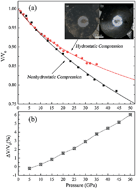Structural stability and compressive behavior of ZrH2 under hydrostatic pressure and nonhydrostatic pressure
Abstract
The important transition metal dihydride ZrH2 has been characterized using in situ synchrotron X-ray diffraction combined with diamond anvil cell techniques and ab initio calculations. The effect of a pressure-transmitting medium on the structural stability and compressive behavior was investigated under both hydrostatic pressure and nonhydrostatic pressure conditions. The ambient I4/mmm structure is stable under both nonhydrostatic and hydrostatic compressions. The supplementary theoretical calculations have proposed that the I4/mmm structure transformed into the P4/nmm structure above 100 GPa confirming the stability of the I4/mmm structure during the experimental runs. The difference in the volume reduction between the two compressions becomes larger with increasing pressure. Up to about 50 GPa, the volume collapse of nonhydrostatic compression is 6% relative to the hydrostatic compression. The present study offers a new approach with nonhydrostatic compression or shear stress for finding higher volumetric density hydrogen structures in metal hydrides.


 Please wait while we load your content...
Please wait while we load your content...